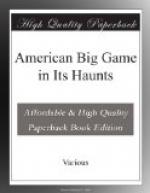After we had finished this horseback trip we went on sleds and skis to the upper Geyser Basin and the Falls of the Yellowstone. Although it was the third week in April, the snow was still several feet deep, and only thoroughly trained snow horses could have taken the sleighs along, while around the Yellowstone Falls it was possible to move only on snowshoes. There was very little life in those woods. We saw an occasional squirrel, rabbit or marten; and in the open meadows around the hot waters there were geese and ducks, and now and then a coyote. Around camp Clark’s crows and Stellar’s jays, and occasionally magpies came to pick at the refuse; and of course they were accompanied by the whiskey acks with their usual astounding familiarity. At Norris Geyser Basin there was a perfect chorus of bird music from robins, purple finches, uncos and mountain bluebirds. In the woods there were mountain chickadees and nuthatches of various kinds, together with an occasional woodpecker. In the northern country we had come across a very few blue grouse and ruffed grouse, both as tame as possible. We had seen a pigmy owl no larger than a robin sitting on top of a pine in broad daylight, and uttering at short intervals a queer un-owllike cry.
[Illustration: Magpies.]
The birds that interested us most were the solitaires, and especially the dippers or water-ousels. We were fortunate enough to hear the solitaires sing not only when perched on trees, but on the wing, soaring over a great canon. The dippers are to my mind well-nigh the most attractive of all our birds. They stay through the winter in the Yellowstone because the waters are in many places open. We heard them singing cheerfully, their ringing melody having a certain suggestion of the winter wren’s. Usually they sang while perched on some rock on the edge or in the middle of the stream; but sometimes on the wing. In the open places the western meadow larks were also uttering their singular beautiful songs. No bird escaped John Burroughs’ eye; no bird note escaped his ear.




